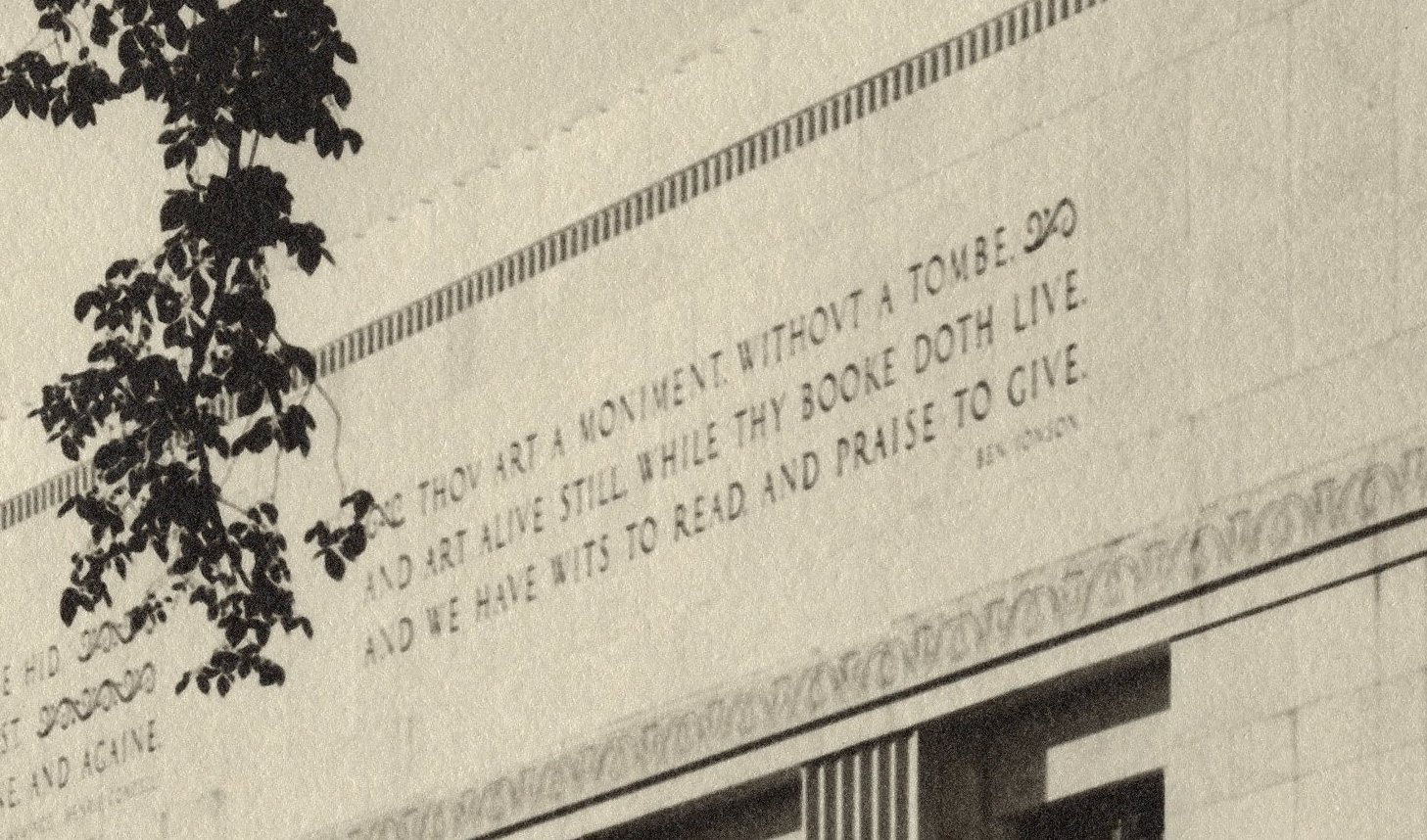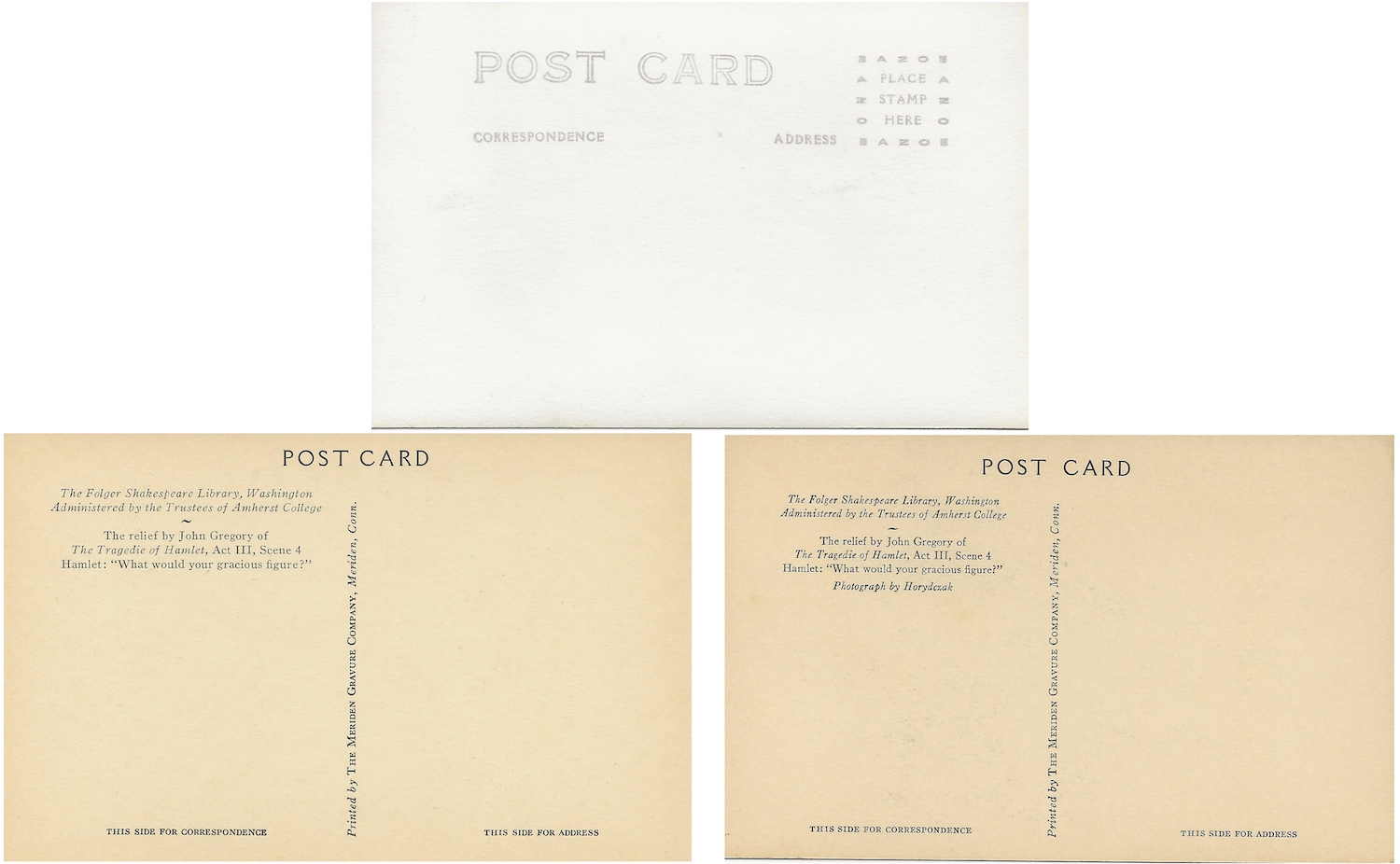It is my pleasure to show you two early sets of picture postcards of the Folger’s bas-reliefs designed by John Gregory. On the left you have photographic cards printed on Kodak (AZO) Paper. I’m hoping someone will identify the photographer. On the right you have gravure cards printed by the Meriden Gravure Company of Meriden CT. Unlike the AZO postcards, which are photographs printed on light-sensitive paper, the gravure postcards are printed with printing ink on cardstock. The photographer for 8 of the 9 gravure cards is credited on the back of each postcard as Theodor Horydczak. The first three panels are presented here in the order (from left to right) in which they appear on the Library façade at 201 East Capitol St., SE.
A Midsummer Night’s Dream
Left: An AZO postcard
Right: A Meriden Gravure Co. postcard
(Author’s Collection, photos by Stephen Grant)
Romeo and Juliet
Left: An AZO postcard
Right: A Meriden Gravure Co. postcard
(Author’s Collection, photos by Stephen Grant)
Merchant of Venice
Left: An AZO postcard
Right: A Meriden Gravure Co. postcard
(Author’s Collection, photos by Stephen Grant)
The gravures show the name of the Shakespeare play as it is carved in the block of marble. The AZO photos lack enough contrast for the carving to show up, so they have superimposed the play titles in white letters. Note the difference in the gravure shadows compared to AZOs: the gravures clearly show the shadows, whereas the AZOs lack the contrast.
On Aug. 2, 1929 the Folgers made known to their principal architect, Paul Philippe Cret, the plays and the scenes from Shakespeare’s plays they had selected for the bas-reliefs (Folger Archives Box 57). On Aug. 9, 1929, Folger wrote to Cret again regarding the inscriptions they chose for the upper north façade. One of the quotes, from Ben Jonson, includes “Thou art a Moniment without a tombe.” Folger insisted that his architects and sculptors reproduce the historical spelling.
Detail of 1934 photograph by Horydczak showing the Jonson quotation.
(Folger Archives Black Box 6) (Image from LUNA, click for full version)
Folger consulting architect Alexander Trowbridge reported years later that as the Jonson quote and other inscriptions were being chiseled into the marble, a visitor frantically appeared at the door. “I thought I had better come in and tell you that the men who are doing the carving outside don’t know how to spell. They’ve got ‘mirror’ spelt with a ‘v’ and ‘again’ spelt with a final ‘e.’ You’d probably better go out and stop them before they spoil the whole wall.” (James Waldo Fawcett, “Charm of Ordinary Print,” Sunday Star, Jan. 24, 1932)
None of these 6 postcards is dated, bears a postage stamp, was sent through the mail, or carries a message. None has a serial number. I’ll show the reverse side of one AZO and two gravures (from a different postcard in the same series).
Top: reverse side of an AZO postcard
Bottom Left: reverse side of a Meriden Gravure Co. postcard without Horydczak’s name
Bottom Right: reverse side of a Meriden Gravure Co. postcard with Horydczak’s name
(all from Author’s Collection, photos by Stephen Grant)
In addition to the printed POST CARD, CORRESPONDENCE, AND ADDRESS, note what is printed in the upper right-hand corner besides PLACE STAMP HERE: on all four sides is printed AZO. AZO is a silver chloride photographic printing paper manufactured by Eastman Kodak.
There is a reason that I show two versions of the reverse side of a Meriden Gravure Co. Hamlet postcard. One identifies the photographer as Horydczak, and the other does not identify the photographer. Perhaps Horydczak noticed that the printer has neglected to attribute the photo of the Hamlet panel to him and made a stink?
Finally, a comment on the Midsummer Night’s Dream panel. It is not generally known that John Gregory’s original model included a nude. According to a letter in the Cret Papers, held at the University of Pennsylvania, on June 20, 1930, Trowbridge wrote Cret, “Mrs. Folger did not like the idea of having a nude figure.” Gregory replaced it with a depiction of Bottom with the donkey’s head.
(This post was originally published on the Folger Shakespeare Library’s research blog The Collation on September 20, 2020.)
COMMENTS:
CONNECT






0 Comments